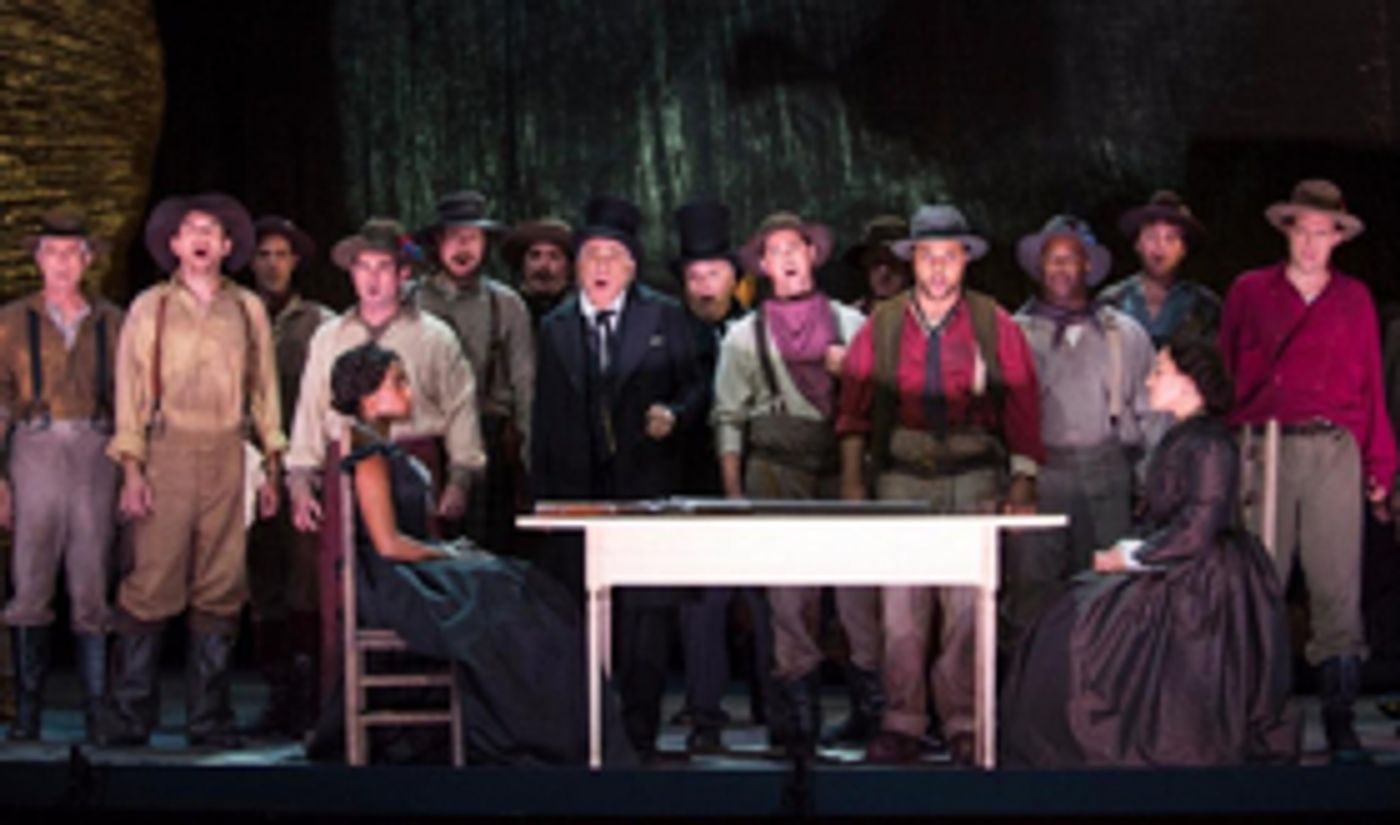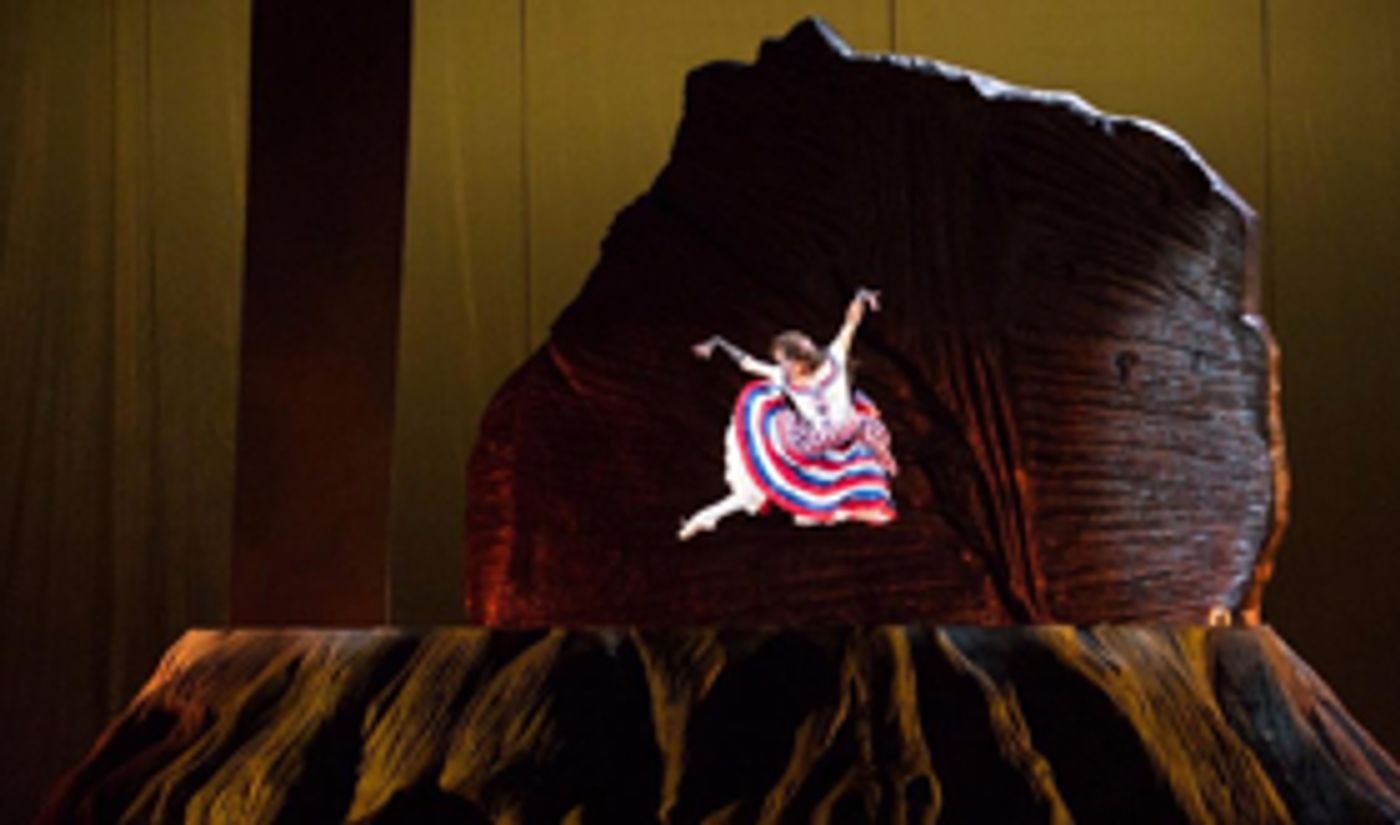BWW Preview: World Premiere of Adams's GIRLS OF THE GOLDEN WEST with Librettist-Director Sellars at San Francisco Opera, Nov. 21

rehearsal. Photo: Stefan Cohen/San Francisco Opera
Anyone arriving at the San Francisco Opera expecting that the new John Adams-Peter Sellars collaboration, GIRLS OF THE GOLDEN WEST, will sound like any of their previous projects--THE DEATH OF KLINGHOFFER, DR. ATOMIC (also a SF Opera commission) or NIXON IN CHINA--will probably be in for a big surprise. The opera has its world premiere on November 21 in what was once a small town until the boom of California's Gold Rush.
The collaborators gave some indication of the style and thrust of the opera at the Guggenheim Museum's "Works & Process" series in New York early this fall, which featured a discussion of the new opera between composer Adams, director/librettist Sellars and San Francisco Opera General Director Matthew Shilvock. Adams and Sellars revealed the genesis of the project, along with their ' connection to the material.

Photo: The John Adams Institute
While the idea for the opera came from Sellars--as it had for their other collaborations--Adams took to it instantly and has been "absolutely devoted to it." Sellars said that the two "went back and forth more on this piece more than any we've any worked on." The director/librettist recalls that there were three major drafts, quite different from one another.
Here are some other revelations, taken from the "Works & Process" conversation.
What is it like?
Any resemblance between the new opera and a work by Puccini is in name only. Indeed, the project started out with a call to Sellars from La Scala in Milan, offering him Puccini's LA FANCIULLA DEL WEST (GIRL OF THE GOLDEN WEST)--they called it "the perfect opera" for his house debut. When he stopped rolling his eyes--because he considered the work about as bad a fit for him as he could imagine--he decided to do some research on the California Gold Rush era before giving an answer, even though his intention was to decline. (His mother's voice made him do it, he said.) But even if it didn't lead to Puccini and La Scala, the history he discovered stayed with him.
GIRLS is a testosterone-filled piece that definitely has humor in it but can also be grizzly. It tells of men from "Egypt, Brazil, Australia, Russia, everywhere in the world" who came to California for gold and performed Shakespeare around the campfires (yes, they did that!), Native American genocide (history books call it "extermination") disguised as weekend sport by the miners and the hanging of a Mexican woman, Josepha Segovia, who had the temerity to stand up for herself against white men.

Feijoo. Photo: Stefan Cohen/San Francisco Opera
It's a mosaic that tells the fascinating, horrifying story of the multicultural experience that was the California Gold Rush, and does it in a way unlike any other account of the era: through the words of people who were there. These run the gamut from the elegant letters of Dame Shirley--the pen name of Louisa Knapp Clappe, an Easterner who went west at the end of the 1840s with her husband, who was finishing his medical studies, and decided to experience Gold Rush, which was sweeping through northern California at that time--to the songs heard in the mining camps, whose lyrics have made their way into the libretto, now set to music by Adams. Dame Shirley is the opera's protagonist, though far from its only story.
The cast of characters, in fact, is "fantastic," said Sellars. In the Gold Rush, everybody is young, so there's a cast of "the most brilliant young singers from around the world," Sellars added. "The energy on stage is very high and youthful," says the director/librettist. "The work is like NIXON IN CHINA in that it's hilarious, nonstop strange comedy, and the longer you look, the more disturbing it is, and moving, with this complex, interesting texture."
While the arc of it is very human, said Sellars, as people tell their stories, it takes place at a very powerful moment in American history--the first 4th of July in the new state of California, and the day after.
How did it start?
Sellars and Adams are what might be called "a mutual admiration society": Adams loves working with Sellars--he called it 'a complete total immersion experience'--while Sellars proclaimed his awe of the composer's intensity when he goes to work.
When Sellars met with Adams to discuss a new project, the director recalled, they started from square one and ran into many blank walls before Sellars mentioned the Gold Rush; Adams took to it immediately. Adams has very strong feelings about California--he's lived there for over 40 years, though he was born in Massachusetts--and has a cabin in the Sierras not far from Downieville, where much of the action takes place.
While the research for the project may have started with Sellars, Adams picked up the pace, in spades, becoming obsessed with reading about California history and spending. "countless hours" on universities' archival websites, including the lode at the Bancroft Library at the University of California-Berkeley, "looking at images of people and trying to imagine what their lives were like."
Dame Shirley, for example, wrote 23 letters to her sister in Massachusetts that have survived, "one of the most exquisite chronicling of the Gold Rush that exist," according to Shilvock. Adams and Sellars have woven them into the fabric of the opera, using them to expose "not only the beauty and the excitement, but the horrors and tensions of the Gold Rush."
(According to Sellars, Dame Shirley was just not impressed by these blowhards in the mining camps. She wrote about how they worked like crazy all week long, dug huge, 40-foot deep holes looking for gold and would then get blind drunk on Saturday night and fall into a hole and break their legs. "There's a strange combination of humor and gritty existence that is cheek by jowl with violent moments of murder and jealousy," he said.)
One of those horrors was "a shocking story" that Adams knew in part, from 1851. It concerned the lynching of Josepha Segovia (mentioned earlier), one of the few women in this area. Adams thought that if they could incorporate that story into several others that they'd have a work with "great human and emotional and psychological depth." He also liked that it took place in an area he knew well. "What I like often about great works of art, whether a novel by Hardy or an opera by Janacek, is that they were writing about their own backyard," Adams commented. He felt that it was something that he could do.
The libretto was a collaboration between the two, because, said Sellars, "it's really hard writing a libretto for this man who is so literary. You mention the California mining songs and the next time you see him, he's read another 45 of them and he's saying what about this one...that one. He's absolutely devoted to the work."
What does it sound like?
Musically, this is not necessarily an opera with lots of "conventional" arias--though there's nothing ordinary, ever, about Adams's writing--but there are several notable ones. This includes one for the famous freed slave-social reformer-statesman, Frederick Douglass about "what it means to be a freed slave on the 4th of July" and another for the Dame Shirley as Lady Macbeth; there's also a great dance piece about the Irishwoman who became a famous Spanish dancer, ""Lola Montez Does the Spider Dance."
But the score draws heavily on the song tradition of the Gold Rush, with the libretto incorporating some of the lyrics being sung in the mining camps, though none of the music, since they were all set to very familiar songs of the day. Said Sellars, "Brecht and Weill were looking at the songs when they wrote THE RISE AND FALL OF THE CITY OF MAHAGONNY--these are the real things, with these miners telling horrible stories about themselves and buying another round of drinks for everyone at the end of the song."
When asked about his musical influences in writing for the piece, Adams discussed how he didn't want to take simple texts that all were in a kind of "iambic pentameter" (one short or unstressed syllable followed by one long or stressed syllable) "and set it to reversible 12-tone crab canons" (i.e., because the crab looks forward while walking backwards). "You try to find a musical language that has that same simplicity and directness." He noted that "in some ways, people who have heard pieces of mine, my orchestra pieces, will be surprised" because so much of this opera feels like that.
Sellars added, that there's a level of "testosterone and energy in these songs"--for the all-male chorus of miners--is a wonderful counterpoint to the poetic text for Dame Shirley and other female characters.
According to Shilvock, it's a critically important story for San Francisco and it's a critically important story given what's happening in this country. "This is not just a historical piece," he continued, "but a piece about modern day America as well as its past. California in the 1850s was "a place of great optimism, fervor and hope; you have people streaming into the city, jamming into every corner possible, trying to make quick wealth, believing anything is possible; the relationship of that energy to the Gold Rush is quite profound. "
The public lynching of Josepha in Scene 5 of Act II, is something terrifying, said Sellars. "John wrote 100 pages of music for it--and the first time we heard that music was several weeks ago, when news of the white supremacists marching in Charlottesville was exploding. It was like hearing [the Brecht-Weill] MAHAGONNY in 1932." Sellars explained, "You realize John has actually touched what's going on--and a hundred years from now, if people want a time capsule of what this moment felt like to be alive in America, they'll have it in this piece of music."
Said Shilvock, "It was such a mythical time, a time that people all over the world feel some connection to--the romance of it, the optimism, the sense of pioneering. Even if we in San Francisco find a particular resonance in it, when it goes to Dallas, when it goes to Amsterdam, and other places, it will speak to those audiences as well."
###
GIRLS OF THE GOLDEN WEST by John Adams and Peter Sellars, directed by Sellars, is a co-commission and co-production with the Dallas Opera and the Dutch National Opera, Amsterdam. It will be performed at the San Francisco Opera on the following dates: November 21 (7:30 p.m.), 24 (7:30 p.m.), 26 (2 p.m.), 29 (7:30 p.m.); December 2 (7:30 p.m.), 5 (7:30 p.m.), 7 (7:30 p.m.), 10 (2 p.m.), 2017. For more information and tickets, see the website.
Conductor - Grant Gershon
San Francisco Opera Orchestra, Chorus and Dance Corps
Soprano Julia Bullock - Dame Shirley
Bass-baritone Davone Tines - Ned Peters, an African-American cowboy
Tenor Paul Appleby - Joe Cannon, a lonely miner
Soprano Hye Jung Lee - Ah Sing, a Chinese prostitute
Mezzo-soprano J'Nai Bridges - Josefa Segovia
Bass-baritone Ryan McKinny - Clarence, a hard-luck miner
Baritone Elliot Madore - Ramón, the Chilean bartender of the Empire Hotel.
Dancer Lorena Feijóo - Lola Montez
Set design - David Gropman
Costume design - Rita Ryack
Lighting design - James F. Ingalls
Sound design - Mark Grey
Choreography - John Heginbotham
Videos

